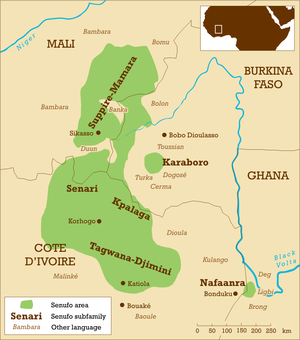Our website is made possible by displaying online advertisements to our visitors.
Please consider supporting us by disabling your ad blocker.
Senufo languages
This article includes a list of general references, but it lacks sufficient corresponding inline citations. (September 2024) |
| Senufo | |
|---|---|
| Senoufo | |
| Geographic distribution | northern Ivory Coast, southern Mali, southwestern Burkina Faso, western Ghana |
| Linguistic classification | Niger–Congo?
|
| Subdivisions | |
| Language codes | |
| Glottolog | senu1239 |
 Map of the Senufo language area showing the major groups and some neighbouring languages. | |
The Senufo or Senufic languages (French: Senoufo) comprise around 15 languages spoken by the Senufo in the north of Ivory Coast, the south of Mali and the southwest of Burkina Faso. An isolated language, Nafaanra, is also spoken in the west of Ghana. The Senufo languages constitute their own branch of the Atlantic–Congo sub-family of the Niger–Congo languages. Anne Garber estimates the total number of Senufos at some 1.5 million; the Ethnologue, based on various population estimates, counts 2.7 million.[year needed]
The Senufo languages are bounded to the west by Mande languages, to the south by Kwa languages, and to the north and east by Central Gur languages.
The Senufo languages are like the Gur languages in that they have a suffixal noun class system and that verbs are marked for aspect. Most Gur languages to the north of Senufo have a two tone downstep system, but the tonal system of the Senufo languages is mostly analysed as a three level tone system (High, Mid, Low).
The Senufo languages have been influenced by the neighbouring Mande languages in numerous ways. Many words have been borrowed from the Mande languages Bambara and Jula. Carlson notes that "it is probable that several grammatical constructions are calques on the corresponding Bambara constructions".[1] Like Mande languages, the Senufo languages have a subject–object–verb (SOV) constituent order, rather than the subject–verb–object (SVO) order which is more common in Gur and in Niger–Congo as a whole.
- ^ Carlson (1994), p. 2.
Previous Page Next Page


